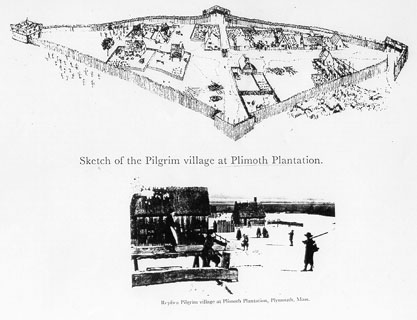This sketch, copies of which are available from the Plimoth Plantation Museum, is an historical reconstruction based on documentary accounts. Jason Boroughs' thesis, A New Insight into the Early Settlement of Plymouth Plantation, in this Plymouth Colony Archive, provides the following observations concerning this sketch:
The previous first person accounts were used to create a working model of the town of New Plymouth by the living history museum known as Plimoth Plantation. The depiction is of a diamond shaped, palisaded town with houses lined up on either side of a main street. Garden plots are located behind the houses and continue to the extent of the palisade wall. At the center of the town is the intersection with the "square stockade upon which four patereros are mounted" identified by de Rasieres. Of the four points of the diamond shaped palisade wall, three are quadrangular bastions with entrance gates and the fourth is a square blockhouse and watch tower complete with ordnance.
The model is a very useful tool and helps us to visualize the previously mentioned accounts of the town. However, there are a few possible flaws in the rendering that are worthy of noting. For example, the bastions in the model are quadrangular and most likely would have been circular, as in other English frontier fortifications of the time (Kelso 1996: 34-35). The shape of the palisade walls is unknown and could have existed in many forms, therefore the depiction of a diamond shaped town is as good a guess as can be made until archaeologists can prove otherwise. The final discrepancy in the Plimoth Plantation depiction is that it is too small. If the dwelling and population counts in the previous descriptions of the town are believed to be accurate than the model must be greatly expanded in order to hold more house and garden plots. However, it must be remembered that the Plimoth Plantation rendering is a model and is not meant to be a literal depiction of the town, therefore its greatest value is as a reference material.

Maps and Landscape
Material Culture
Project Home Page
Last Modified: December 14, 2007
|
